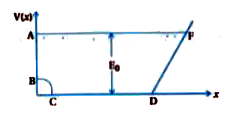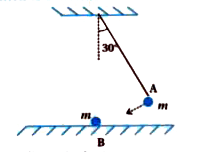Complete Solutions to SECTION - D NCERT Exemplar Solutions (Short Answer Type Questions) of chapter WORK, ENERGY AND POWER of Class 11 book with complete answers and questions
| Class 11 | PHYSICS |
| Chapter | WORK, ENERGY AND POWER |
| KUMAR PRAKASHAN | SECTION - D NCERT Exemplar Solutions (Short Answer Type Questions) |
| Number Of Questions | 10 |
| Academic Year | 2023-24 |
A graph of potential energy V(x) verses x is shown in figure .A particle of energy `E_(0)` is executing motion in it . Draw graph of velocity and kinetic energy verses x for one complete cycle AFA.

View SolutionA ball of mass m , moving with a speed `2v_(0)` collides inelastically `( e gt 0)` with an identical ball at rest . Show that
(a) For head - on collision , both the balls move forward .
(b) For a general collision , the angle between the two velocities of scattered balls is less than `90^(@)`
View SolutionConsider a one -dimensional motion of a particle with total energy E. There are four regions A,B,C and D in which the relation between potential energy E. There are four regions A,B,C and D in which the relation between potential energy V, kinetic energy (K) and total energy E is as given below
Region `A : V gt E ` Region `B: V lt E`
Region `C :K gt E` Region `D : V gt E` .
State with reasons in each
View SolutionThe bob A of a pendulum released from `30^(@)` to the vertical hits another bob B of the same mass at rest on a table as shown in figure . How high does the bob A rise after the collision ? Neglect the size of the bobs and assume the collision to be elastic .

View SolutionA raindrop of mass 1.00 g falling from a height of 1m hits the ground with a speed of 50`ms^(-1) ` Calculate
(a) the loss of PE of the drop
(b) the gain in KE of the drop
( c ) Is the gain in KE equal to loss of PE ? If not why ?
Take,` g =10 ms^(-2)`
View SolutionTwo pendulums with identical bobs and lengths are suspended from a common support such that in real position the two bobs are in contact (figure). One of the bobs is released after being displaced by` 10^(@)` so that it collides elastically head-on with the other bob.
(a) Describe the motion of two bobs.
(b) Draw a graph showing variation in energy of either pendumlum with time, for `0 le t le 2T` , where T is the period of each pendulum.

View SolutionSuppose the average mass of raindrops is `3.0 xx 10^(-5) kg` and their average terminal velocity `9 ms^(-1)` . Calculate the energy transferred by rain to each square metre of the surface at a place which receives `100 cm` of rain in a year.
View SolutionAn engine is attached to a wagon through a shock absorber of length `1.5 m`. The system with a total mass of 50,000 kg is moving with a speed of `36 ^kmh(-1)` when the brakes are applied to bring it to rest, the spring of the shock absorber gets compressed by 1.0 m. If `90 % ` of energy of the wagon is lost due to friction, calculate the spring constant.
View SolutionAn adult weighting 600 N raises the centre of gravity of his body by 0.25 m while taking each step of 1 m length in jogging. If he jog for 6 km, calculate the energy utillised by him in jogging assuming that there is no energy loss due to friction of ground and air. Assuming that the body of the adult is capable of converting 10% of energy intake in the form of food. calculate the energy equivalents of food that would required to compensate energy utilised for jogging.
View SolutionOn complete combustion a litre of petrol gives off heat equivalent to ` 3 xx 10^(7) `J. In a test drive, a car weighing 1200 kg including the mass of driver, runs 15 km per litre while moving with a uniform speed on a straight track. Assuming that friction offered by the road surface and air to be uniform. calculate the force of friction acting on the car during the test drive. if the efficiency of the car engine were 0.5.
View Solution
SECTION - D NCERT Exemplar Solutions (Short Answer Type Questions) questions and complete solutions for chapter WORK, ENERGY AND POWER of KUMAR PRAKASHAN KENDRA PHYSICS (GUJRATI ENGLISH) of Class 11
All Exercises from KUMAR PRAKASHAN Class 11 PHYSICS WORK, ENERGY AND POWER
- QUESTION PAPER (SECTION - A)
- QUESTION PAPER (SECTION - B)
- QUESTION PAPER (SECTION - C)
- QUESTION PAPER (SECTION - D)
- SECTION - A Questions - Answers (Introduction)
- SECTION - A Questions - Answers (Try Yourself (VSQs))
- SECTION - B Numericals (Numerical From .DARPAN. Based On Textbook)
- SECTION - B Numericals (Numerical From Textual Exercise)
- SECTION - B Numericals (Numerical From Textual Illustration)
- SECTION - C Objective Questions (VSQs)
- SECTION - D NCERT Exemplar Solutions (Long Answer Type Questions)
- SECTION - D NCERT Exemplar Solutions (Multiple Choice Questions)
- SECTION - D NCERT Exemplar Solutions (Short Answer Type Questions)
- SECTION - D NCERT Exemplar Solutions (Very Short Answer Type Questions)
- SECTION - E Multiple Choice Questions (MCQs)
- SECTION - F Questions From Module (Sample questions for preparation of competitive exams)